ntroduction
Plasmodesmata are narrow channels that act as intercellular cytoplasmic bridges to facilitate communication and transport of materials between plant cells. The plasmodesmata serve to connect the symplastic space in the plant and are extremely specialized channels that allow for intercellular movement of water, various nutrients, and other molecules (including signalling molecules) (Epel, 1994). Plasmodesmata are located in narrow areas of cell walls called primary pit fields, and they are so dense in these areas (up to one million per square millimeter) that they make up one percent of the entire area of the cell wall (Salisbury and Ross, 1992):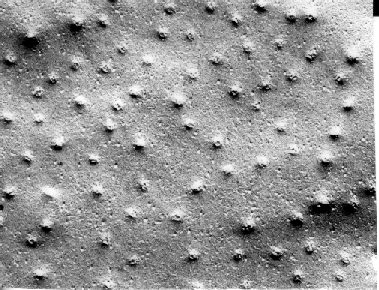
--figure from Micrograph of the Month at Brown University, Dr. Kenneth R. Miller
Ever since the electron microscope was introduced into the battery of scientific tools available to researchers, plasmodesmal studies have become an exciting field in plant physiology. When previously it was thought that these pores were merely passive tunnels for small solute transport between cells, there are now fervent debates about the structure, composition, and active transport dynamics of these intercellular channels.
Composition and Structure
Since the function of plasmodesmata are so closely associated with their rather complex structure, it is necessary to delinate the make-up of plasmodesmata before we discuss their functions in plants. It has been demonstrated that the plasma membrane is continuous between cells, the outer leaflet contiguous with the cell wall and the inner leaflet contiguous with the plasmodesmal pore (general structure reviewed by Epel, 1994; Overall and Blackman, 1996; and Oparka, 1993). Within the plasmodesmal pore, a tightly wound cylinder of membrane termed the desmotubule runs the length of the plasmodesma. Thus, the desmotubule is essentially a tube within a larger tube bordered by the plasma membrane. The structure of the desmotubule and how it relates to the overall structure of plasmodesmata was studied by Tilney, et al. (1991) by using plasmolysis, Triton X detergent extraction, and protease digestion. This investigation utilized fern (Onoclea sensibilis) gametophytes by cutting them in half, exposing the cut surfaces to Triton X 100, and then fixing the gametophytes. This detergent solubilized the plasma membrane component of the plasmodesmata of the gametophytes, but the desmotubule was not affected by the detergent. However, when the cut gametophyte surfaces were exposed to papain, the desmotubule is destroyed but the plasma membrane remained intact (yet swollen). Finally, the gametophytes were plasmolyzed, and it was found that plasmodesmata remained intact as long as the desmotubule stayed in its normal, fixed position as the cells detached from the cell walls. Thus, Tilney, et al. (1991) suggested that the desmotubule provides a rigid stability to plasmodesmata and confers a fixed diameter and pore size to the plasmodesmal canal, much like a cytoskeletal structure. However, one should be cautious in mistaking the desmotubule as a completely rigid strcuture, since the desmotubule is linked to the endoplasmic reticulum in each of the adjacent cells, forming a dynamic endomembrane continuum in the symplastic space, a topic to be discussed in more detail later (Grabski, et al., 1993).The space between the plasmalemma and the desmotubule is the cytoplasmic sleeve or cytoplasmic annulus, and transport through plasmodesmata has been proposed to occur either through the lipid portions of the desmotubule or this cytoplasmic sleeve (or both):

--figure from Oparka, 1993
In some plasmodesmata, there is a region at each end of the plasmodesmal channel that is constricted and termed the neck region, where the plasma membrane component of the plasmodesmata closely associates with the central desmotubule. The neck region is proposed to contain several, spoke-like protein subunits that are located both extracellularly and between the desmotubule and the plasmalemma (linking these two structures), and these proteins can then act as a sphincter to regulate the passage of materials through the plasmodesmata, much like gap junctions in animal cells (reviewed by Robards and Lucas, 1990):

--figure from Robards and Lucas, 1990
Recently, studies by White, et al. (1994) have suggested that there is an actin-myosin network associated with plasmodesmata, since these proteins were found to be associated with plasmodesmata using immunogold cytochemistry. Overall and Blackman (1996) suggest that the actin and myosin wrap around the central desmotubule and help to stabilize the desmotubule and consequently the entire plasmodesma. They support their claim by providing evidence that treatment of plant tissue with cytochalasin (which interferes with actin structures) have cells with plasmodesmata that are swollen, much like the plasmodesmata in the gametophyte tissue exposed to papain in the investigation by Tilney, et al. (1991). The possible roles of actin and myosin in plamodesmal function are discussed below. Here is the most recent diagramatic model of plasmodesmal structure, proposed by Overall and Blackman (1996):

Electron microscopy has been an essential tool for discerning plasmodesmata structure, but one should be aware that the dynamics of plasmodesmal transport should not and cannot be absolutely inferred from these static images. But, these images are still the major source of information on the substructure of plasmodesmata; here are some examples of electron micrographs of plasmodesmata (figures from Overall and Blackman, 1996; Tilney, et al., 1991; and Hepler, 1982, respectively):
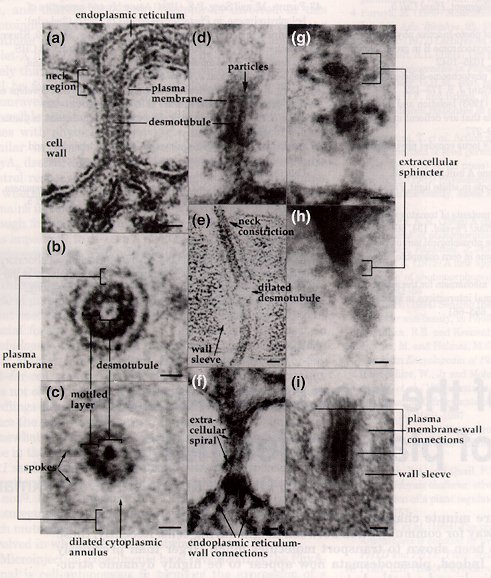
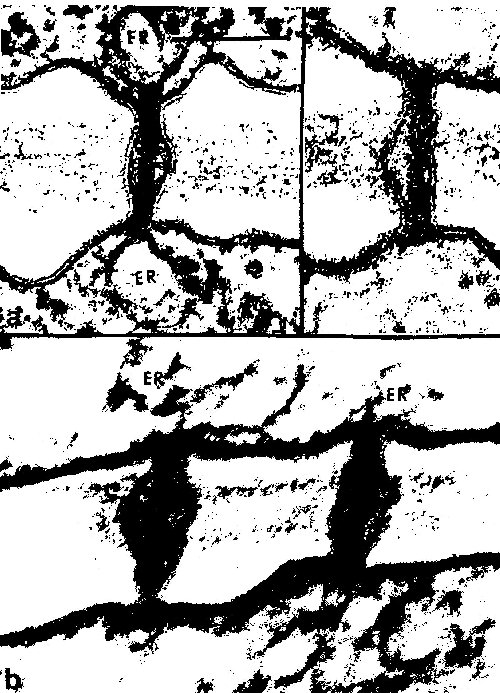
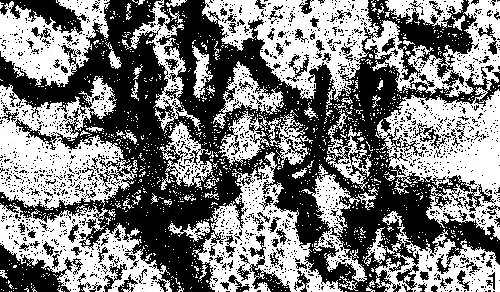
Computer-generated models of plasmodesmata structure have also been useful for describing the three-dimensional characteristics of the plasmodesmal canal. Below are computer-generated images of various models described in the literature (images from Chris Betts at Monash Univ.):

THE DING MODEL
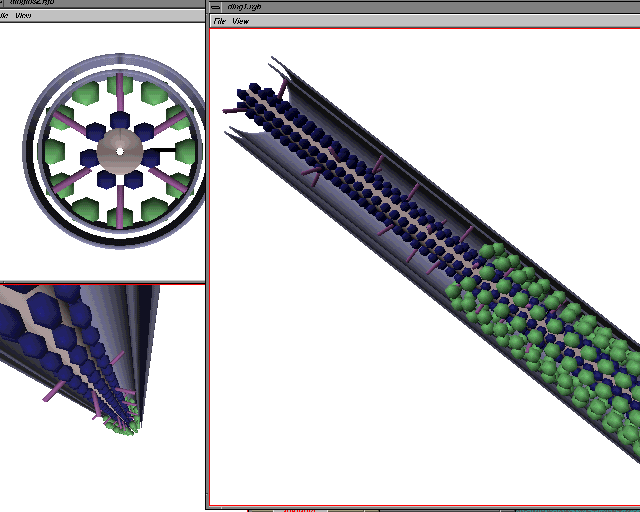

THE OVERALL MODEL
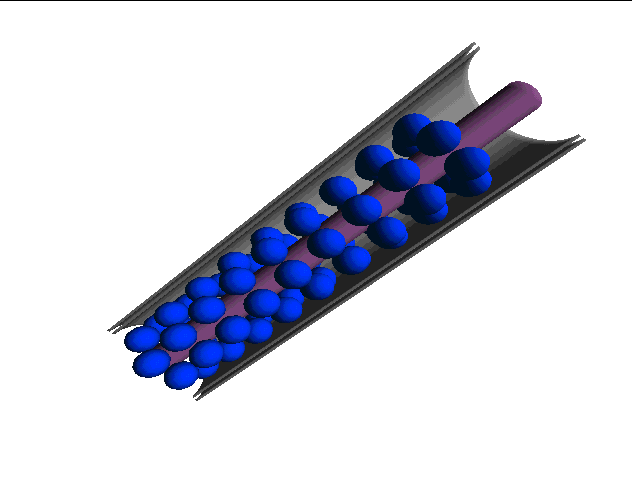

THE RADFORD MODEL


THE WHITE MODEL


A dynamic endomembrane continuum
During cytokinesis of plant cells, the endoplasmic reticulum has been associated with the dictyosomal vesicles of the forming phragmoplast of the dividing cell (reviewed by Hepler, 1982). Sometimes, portions of the endoplasmic reticulum are trapped within these vesicles as they fuse, these tubular ER elements manage to traverse the cell plate, and plasmodesmata are formed. A study by Hepler (1982) substantiated the model that the desmotubule was a tightly furled stretch of endoplasmic reticulum that confers a membranous continuum between adjacent cells. Previous methods for endoplasmic reticulum staining had proved difficult: potassium permanganate (KMnO4) staining managed to stain the ER heavily but did not provide enough structural detail (because it degraded various cellular structures), and glutaraldehyde-OsO4 fixation was gentle enough to not disrupt cytoplasmic details but did not stain heavily enough for proper contrast of ER membrane (Hepler, 1982). However, this study by Hepler (1982) used a novel staining technique that utilized a mixture of osmium tetroxide and potassium ferricyanide to selectively and strongly stain for ER without destroying any cellular structures. Through this staining technique, Hepler (1982) was able to demonstrate that the endoplasmic reticulum did, in fact, run throughout the plasmodesmata of contiguous lettuce (Lactuca sativa) tissue cells, and the cisternal space of the endoplasmic reticulum was occluded by the tightly-constricted neck regions of the plasmodesmata (see electron micrograph # , above), providing support for the notion that the desmotubule was a strong, tightly-wound rod running down the length of plasmodesmata.- The endoplasmic reticulum can serve as a pathway for the transport of various lipids between contiguous plant cells, and thus lipid signaling molecules are able to cross cell walls and membranes. This finding may lead to a model of lipid transfer between endomembrane components, for example endoplasmic reticulum and mitochondria, mediated by diffusion between contiguous membranes.
- Lipids are not capable of transport via the plasmalemma, and there is a chance that the linkages between the plasma membrane and plasmodesmata are protein-protein associations not unlike those found in tight junctions in animal cells. Thus notion leads to the idea that these interactions are inhibiting the leakage of cytoplasmic components around the plasmodesmata (through mobilization in the plasma membrane). Grabski et al. (1993) suggests that this tight junction-like function of the plasmalemma-plasmodesmata interface may be a target for viral disruption of the plasmodesmata, allowing viruses to escape into adjacent cells quite easily.
Signaling and Transport Mechanisms of Plasmodesmata
Classical studies on transport through plasmodesmata have utilized microinjection of small, fluorescently-labeled probes to examine the passive transport mechanisms of plasmodesmata. These probes were first used to describe the size-exclusion limits, or the maximum size of a molecule that can pass through plasmodesmata passively, of plasmodesmata in various plant species. Looking at the cytoplasmic sleeve region and the spokes that constrict the neck region plasmodesmata, it was determined that the average width of channels allowing molecules to passively travel through a plasmodesmal annulus is approximately 3 nm, and thus the average size exclusion limit is molecules weighing approximately 800-1000 Da (reviewed by Oparka, 1993; Epel, 1994; Robards and Lucas, 1990; and Overall and Blackman, 1996).
Variations on passive transport
However, it has recently been shown that size exclusion limits vary between species and even cell types during passive transport. In tobacco mesophyll cells, the size exclusion limit of fluorescently-labeled dextrans is only 1 kDa, whereas in trichome cells, the size-exclusion limit is as large as 7 kDa (reviewed by Overall and Blackman, 1996 and Epel, 1994). Another study by Wang and Fisher (1994) employed normally apoplastic probes such as Lucifer Yellow and incubated sections of crease tissue from developing wheat grains in solutions of these probes. The dye moved into the symplastic space through plasmodesmata, and it was determined that in all cells except the pericarp, the diameter of the plasmodesmata in this tissue was 6.2 nm (twice the normal exclusion limit).Active transport of macromolecules
Other macromolecules destined for intercellular transport are shuttled through plasmodesmata via active transport mechanisms. Some studies have shown that plasmodesmata can alter their dimensions such that they expand/dilate outward into an electron-lucent sleeve surrounding the normal-sized plasmodesmata (reviewed by Overall and Blackman, 1996). This expansion would allow for the transport of larger molecules through the cytoplasmic sleeve. The mechanism or trigger of this plasmodesmal dilation is virtually unknown, but it has been recently postulated that proteins in the neck region may be implicated in this phenomenon (Overall and Blackman, 1996).
Viruses and Plasmodesmata
A special subset of active plasmodesmal transport involves the intercellular movement of plant viruses through plasmodesmata. Most, if not all, plant viruses utilize plasmodesmata to travel around and infect an entire plant (Epel, 1994), and there is strong evidence to suggest that the viruses manipulate the plasmodesmata to allow large viral particles (several times larger than the normal size exclusion limt) to pass between cells. The major mechanism of this type of viral transport has been deduced through studies of the tobacco mosaic virus, which encodes for a movement protein (MP) that mediates the transport of a non-virion form of the virus between cells (Epel, 1994). The mechanism is thought to be as follows (adapted from Xiong, 1996):- The movement protein is expressed by the virus
- The MP binds to viral RNA
- This binding facilitates the unfolding of the RNA into a linear rod
- The RNA and bound MP targets and then travels to the plasmodesmata
- The MP interacts with the plasmodesmata to increase the size exclusion limit
- The viral RNA can move through the plasmodesmata to the adjacent cell
Other Functions of Plasmodesmata
Plasmodesmata have also been shown to play a role in numerous other plant cell processes (reviewed by Oparka, 1993):- It has been suggested that plasmodesmata transports gibberellic acid in algae.
- Electric coupling between cells has been associated with the density of plasmodesmata between the cells, and electrical signals play a large role in the initiation of a wound response in plants.
- Plasmodesmata have been shown to be sensitive to various levels of calcium, pH, and light, demonstrating that the mechanisms of plasmodesmata transport are more complex than previously thought.
- Plasmodesmata tend to close when there is a significant pressure differential between adjacent cells, again speaking to a role of plasmodesmata in a wound response upon a loss of turgor pressure.
- The permanent opening or closing of plasmodesmata serve to signify symplastic domains in plants, often compartmentalizing various plant functions (a sort of division of labor), such as in guard cells or in the sieve element-companion cell complex in stems
- Plasmodesmata serve as directors of plant growth and development and may help to determine a program of cell differentiation, such as sealing off root and stem epidermal cells from the rest of the plant. This notion has been supported by a study in which RNA encoding the transcription factor KNOTTED1 (KN1) was localized to all cell layers of the developing maize meristem except the outermost, but the KN1 protein was found in all cell layers (reviewed by Zambryski, 1995). Thus, KN1 is most likely being transported to the outer layer through plasmodesmata, providing a channel through which this and other important signalling and regulatory molecules can pass into other cells.
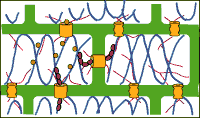 Another major recent finding concerning active transport through plasmodesmata involves a possible association of cytoskeletal elements with both trafficking/targeting molecules to the plasmodesmata and assisting in the energetics of active transport. It has been demonstrated that the endoplasmic reticulum is closely associated with microtubules, and viral movement proteins (discussed below) have been shown to track through the plant cell along these microtubules (reviewed by Overall and Blackman, 1996). Actin and tubulin have both been shown to bind to viral movement protein, which transports itself through the plant via plasmodesmata (reviewed by Zambryski, 1995). Thus, cytoskeletal elements are helping to guide various macromolecules to plasmodesmata, and also actin has been thought to help loosen the sphincter elements of the neck region to allow for the transport of these larger molecules (reviewed by Overall and Blackman, 1996). In addition, myosin may also act as a cytoskeletal motor to provide the energetics for active plasmodesmal transport. Myosin has been found in several species of plants and is an ATP-dependent protein that generates directional movement (as in flagellar motion) (Overall and Blackman, 1996). High ATPase activity has been demonstrated in plasmodesmata, so myosin is a prime candidate for aiding active transport and may be the spokes, sometimes seen in electron micrographs, connecting the desmotubule to the cytoplasmic annulus throughout the plasmodesmata(Overall and Blackman, 1996).
Another major recent finding concerning active transport through plasmodesmata involves a possible association of cytoskeletal elements with both trafficking/targeting molecules to the plasmodesmata and assisting in the energetics of active transport. It has been demonstrated that the endoplasmic reticulum is closely associated with microtubules, and viral movement proteins (discussed below) have been shown to track through the plant cell along these microtubules (reviewed by Overall and Blackman, 1996). Actin and tubulin have both been shown to bind to viral movement protein, which transports itself through the plant via plasmodesmata (reviewed by Zambryski, 1995). Thus, cytoskeletal elements are helping to guide various macromolecules to plasmodesmata, and also actin has been thought to help loosen the sphincter elements of the neck region to allow for the transport of these larger molecules (reviewed by Overall and Blackman, 1996). In addition, myosin may also act as a cytoskeletal motor to provide the energetics for active plasmodesmal transport. Myosin has been found in several species of plants and is an ATP-dependent protein that generates directional movement (as in flagellar motion) (Overall and Blackman, 1996). High ATPase activity has been demonstrated in plasmodesmata, so myosin is a prime candidate for aiding active transport and may be the spokes, sometimes seen in electron micrographs, connecting the desmotubule to the cytoplasmic annulus throughout the plasmodesmata(Overall and Blackman, 1996).
Tidak ada komentar:
Posting Komentar